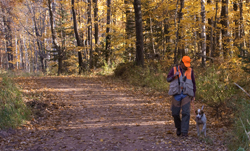How to correct a dog

In this case, Northwoods Aerosmith (Blue Shaquille x Houston’s Belle’s Choice, 2011) receives only praise–not correction–from his owner Ken Taylor.
Even though Gary Larson retired from The Far Side daily cartoon 20 years ago, I still remember many. With clever drawings and simple prose, he succinctly satirized dogs, cats, cows, bears, doctors, scientists and Neanderthals.
Among my favorites was a two-panel cartoon depicting a man admonishing his dog. The panels had the exact same drawing but different headings and different cartoon bubbles.
What we say to dogs
Okay, Ginger! I’ve had it! You say out of the garbage! Understand, Ginger? Stay out of the garbage, or else!
What they hear
blah blah GINGER blah blah blah blah blah blah blah blah GINGER blah blah blah blah blah…
Larson nailed it. Applying strictly human means and psychology when reprimanding a dog doesn’t work. We need to correct in ways that a dog understands.
A well-behaved dog is a partner that’s a pleasure to hunt over and a wonderful family companion. But for safety reasons too it’s essential that a dog responds to corrections. It behooves an owner to master this skill.
Basics
• Be consistent.
• Say the command once and then enforce. You are the leader and must make your dog respond.
Rules
• Timing is crucial. The dog needs to know why it’s being corrected. The best time to correct your dog is to anticipate when it’s going to do something wrong or when just starting to do something wrong. Don’t administer correction afterwards—rather wait until the next time.
• Administer the correction with the right attitude. Use a calm, confident, assertive manner. Don’t get angry.
• Use only enough correction to stop the behavior. Don’t over react or lose your temper.
Options
• Voice: We use QUIT. It’s an easy, one-syllable word and when combined with a low, guttural tone of voice, it gets a dog’s attention. NO isn’t recommended for a pointing dog because it’s similar to WHOA.
• Tools: When the dog is close, try a tug on a leash, check cord or pinch collar. When the dog is a distance away, we prefer an ecollar. Even a rolled-up newspaper whacked near the dog will get its attention.
• Physical: Sometimes, this becomes necessary. Grab the dog by the scruff of the neck, look it straight in the eyes and sternly say QUIT. Never strike or kick a dog.
Some final thoughts…
Consider your dog’s temperament and understand there are differences in learning capability. Dogs can be bold and fearless or soft and timid or some can have a difficult combination of headstrong yet submissive.
Ultimately, you must make your dog respond—whatever it takes.
It’s unlawful to reproduce Larson’s panel but click here to see Ginger and her owner again.




